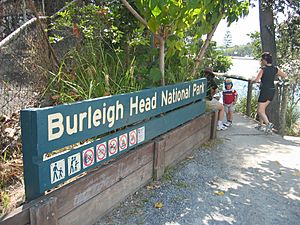Burleigh Head National Park facts for kids
Quick facts for kids Burleigh Head National ParkQueensland |
|
|---|---|
|
IUCN Category II (National Park)
|
|

Headland and Tallebudgera Creek viewed from the south
|
|
| Established | 1994 |
| Area | 0.30 km2 (0.12 sq mi) |
| Managing authorities | Queensland Parks and Wildlife Service |
| Website | Burleigh Head National Park |
| See also | Protected areas of Queensland |
Burleigh Head National Park is a small but amazing park. It is located at Burleigh Heads in South East Queensland, Australia. This beautiful park is part of the famous City of Gold Coast.
Contents
Discover Burleigh Head National Park
This national park is about 90 kilometers (56 miles) south of Brisbane. Even though it's small, the park has many different types of natural areas. Tallebudgera Creek flows into the ocean right next to the park's southern side.
You can't camp inside the park, but it's easy to visit. The Gold Coast Highway runs right past it. There's also an information center if you need help or have questions.
Fun Activities in the Park
Burleigh Head National Park is a very popular spot for people who love to be active. Many enjoy hiking, walking, and jogging here. The park's cool climate and amazing views make it a great place to exercise.
There are two main walking paths in the park:
- Rainforest Circuit: This path climbs up the hill to the top, which is about 88 meters (289 feet) above sea level.
- Ocean View Circuit: This track goes around the headland closer to the ocean.
If you visit at the right time of year, you might even see migrating whales from inside the park!
The Land and How it Formed
The headland at Burleigh Head has very steep sides and is about 80 meters (262 feet) tall. This impressive landform started to take shape a very long time ago. It began between 23 and 25 million years ago!
Back then, the Tweed Volcano was active. Hot, melted rock called basalt lava flowed from the volcano. It filled up valleys and covered old, hardened sedimentary rocks. This lava eventually formed what we now call the Burleigh headland.
Along Tallebudgera Creek, you can find rocky areas and sandy beaches. On the ocean side of the park, there are large black boulders at the bottom of the cliffs. Further up Tallebudgera Creek, where the tide reaches, you'll find a special mangrove forest.
This headland is also a very important cultural site. It holds special meaning for the local Aboriginal people, known as the Minjungbal tribe.
Plants You Can See
Burleigh Head National Park helps protect important areas of rainforest and mangrove forests. These are special places where unique plants grow.
In the western parts of the park, you'll mostly see dry eucalypt forests. Here, you can find trees like:
On the slopes facing the ocean, you'll discover different plants. These include Swamp she-oak, native hibiscus trees, and Pandanus palms. The park also has areas of heathland and tussock grassland.
Animals Living in the Park
Many interesting animals call Burleigh Head National Park home. Keep an eye out for some of these creatures:
- Australian brush-turkeys
- Brahminy kites (a type of bird of prey)
- Sea eagles
- Koalas
You might also spot some reptiles and other mammals:
- Lace monitors (large lizards)
- Echidnas (spiny mammals)
- Mountain brushtail possums
- Common brushtail possums
- Common ringtail possums
Colorful Rainbow lorikeets are often seen in the park. They love to feed on the blossoms of the flowering trees.
Popular Walking Track
The park has a very popular walking track called the Oceanview Track. This path connects Burleigh Heads with Tallebudgera Creek.
In December 2014, the track had to close because some large boulders fell onto the path. After careful work to remove more risky rocks, the track was safely re-opened in mid-2015.
See also
 In Spanish: Parque nacional Burleigh Head para niños
In Spanish: Parque nacional Burleigh Head para niños



